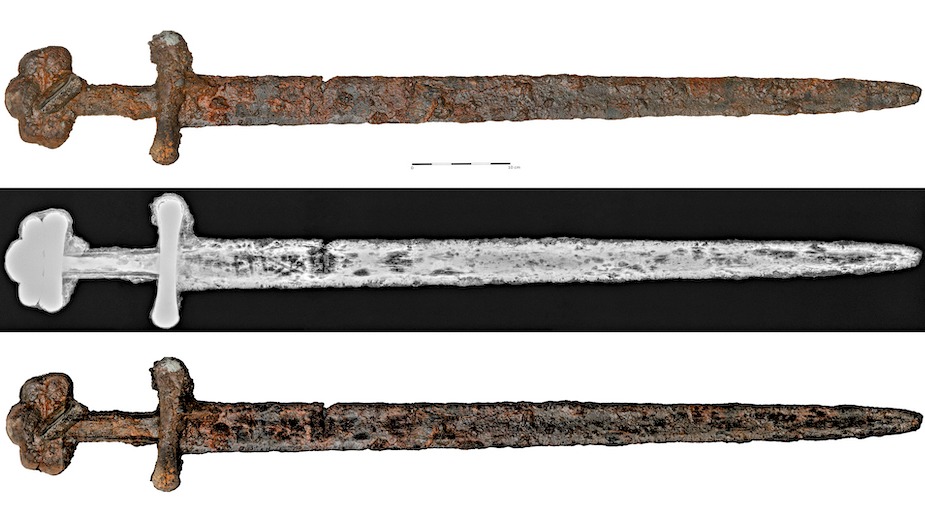Early medieval sword fished out of Polish river is in 'near perfect' condition
A sword dredged from a Polish river could be of Viking origin.

Workers made a surprising discovery in Poland when they pulled an early medieval sword from a muddy riverbed while dredging, and some researchers think the weapon could have a Viking connection.
The 1,000-year-old sword, which is thought to be older than Poland itself, was found cloaked in silt and in "near perfect" condition in the depths of the Vistula (also spelled Wisła) River, which runs through Włocławek, a city in northern Poland, according to Warsaw Point, a Polish magazine.
Local authorities contacted the Provincial Office for the Protection of Monuments about the unusual finding. The city’s Center for Sport and Recreation announced the discovery Jan. 12 via a Facebook post.
X-ray imaging revealed that the sword's blade contained an inscription that reads "U[V]LFBERTH," which could be read as "Ulfberht" — "a marking found on a group of 170 medieval swords found mainly in northern Europe" that may be a Frankish personal name, according to CBS News.
Related: Viking sword from warrior's grave unearthed in family's yard in Norway
Based on the weapon's handle, experts classified it as a "type S" sword, which is characterized by a straight metal cross guard that widens symmetrically near the end. The top of the sword's pommel (handle) contained a three-part cap, a style that enabled researchers to date the sword to the ninth or 10th century, which is around the time when the state of the first Piast dynasty was formed, marking the first Polish form of statehood.
"This is one of the most famous and at the same time the best — in terms of the quality of the blade — early medieval swords from Europe," Mateusz Sosnowski, a specialist with Wda Landscape Park who was involved in the sword survey, told Live Science in an email. "It would be the eighth sword of this type discovered in today's Poland."
Get the world’s most fascinating discoveries delivered straight to your inbox.
Some researchers remain unclear as to how the sword got there in the first place and whether it actually has a Viking connection.
Sosnowski thinks that due to Włocławek's prime location on the river, it could have been an "important shipping route at the time" connecting the city to long-distance routes from the Baltic Sea and Scandinavia.
Additionally, during a highway construction project in 2007, workers discovered a nearby cemetery dating to the 10th and 11th centuries, Sosnowski said.
"During research, many artifacts of Scandinavian origin were found, allowing us to assume that in the necropolis people from Scandinavia were buried there, who may have been in the service of the first Piasts, who were establishing their state in this area at that time," he added.
However, not everyone involved is convinced that the sword is Viking in origin.
Polish archaeologist Robert Grochowski told the Warsaw-based newspaper Gazeta Wyborcza that this type of sword is often referred to as a "Viking sword," even though these swords were forged in what is now France. Many of these weapons came to Central Europe through trade, he added.
"I don't know where the idea that the sword belonged to a Viking comes from," Grochowski said in a translated interview with the newspaper. "Without detailed research, [calling it a Viking sword] is completely unjustified. It is difficult to say anything more than the fact that it is an early medieval sword."
Jennifer Nalewicki is former Live Science staff writer and Salt Lake City-based journalist whose work has been featured in The New York Times, Smithsonian Magazine, Scientific American, Popular Mechanics and more. She covers several science topics from planet Earth to paleontology and archaeology to health and culture. Prior to freelancing, Jennifer held an Editor role at Time Inc. Jennifer has a bachelor's degree in Journalism from The University of Texas at Austin.


